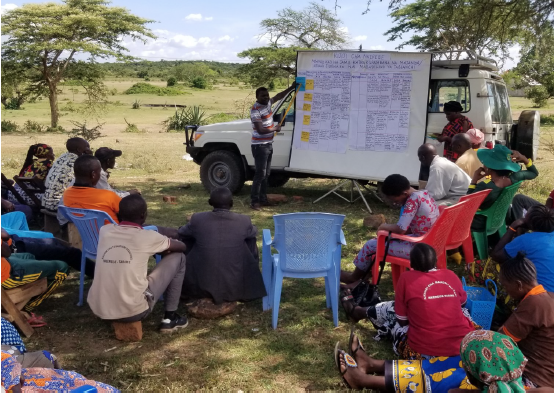For these pastoralist groups, reading and writing have become the new normal.
.jpg)
Find these groups of pastoralist communities, mainly Maasai ethnic under the Farmer Pastoralist Collaboration (FPC) Project located in Vianzi village, Mvomero District. These small groups of pastoralists are primarily engaged in pastoralism as a major socio-economic activity, but a scarcity of grazing lands plus climate change impacts has resulted in confrontations and violence between the two communities (pastoralist and farmers) as a result of an increase in the human population, which is accompanied by a need for land. However, with the adoption of agroecological technologies, the exchange of farm inputs and bi-products made it possible in reducing conflicts through a circular economy approach. With the application of the agroecological best practices in the production systems, the two parts are benefiting from increased productivity and livelihood.
The first phase of the FPC project had an impact. Most pastoralist communities now have the ability to grow their own pasture for their livestock, and confrontations with farmers have decreased. Another biggest challenge confronting pastoralist communities is illiteracy, which is extremely high in these communities due to the fact that most of them had no formal education. It is forbidden for women, in particular, to have formal education, but circumstances have changed, and pastoralist women now desire to school.

Meet Mkombozi pastoralist group, a group of pastoralists with about 31 members, 25 of whom are women and 6 of whom are males, who are keen to know how to read and write. Mkombozi pastoralists are undergoing adult learning training to master the fundamentals of reading and writing. This group was established in early 2019 and started receiving training on livestock keeping, pasture production and saving and lending modules. Mkombozi pastoralist group is one among the groups forming the Namayana milk cooperative association, which requires low literacy among its member groups to ensure the quality and sustainability of the milk cooperative. In June 2020, a group of adults began receiving adult learning training. The group has grown in strength since then, with the majority of its members now being able to read and write.
Mariam Paulo, on the other hand, has piqued our interest in this piece. At Kichangani Village, Mariam is a member of the Mkombozi pastoralist group. But what distinguishes her the most from others?
Mariam Paulo, who is 57 years old and a single mother of five children, is a role model to many. She exemplifies how perseverance and hard effort can lead to success. Mariam's never-ending attempts to learn to read and write truly inspire us all. She joined the group in the middle of 2019 after discovering that many of her friends are now active in agroecological practices and are benefiting greatly from the initiative. Mariam describes the difficulties of being an elderly woman who is unable to read or write.
"I have to wait for my daughter to get out of school and read me the doctor's medical description," she says.
She was once at the hospital and was unable to understand the instruction wall poster, so she did the exact opposite of what was asked.
This sparked her interest in learning to read and write so she could avoid the embarrassment and understand minor details simply by reading. As a result, by 2020, some of the groups in her village were receiving adult learning training, and she was aware of it. Mariam was self-motivated to study before training began at her group, so she walked long distances to learn from other groups far away from her homestead. For example, she walked about 2km to the Mafanikio Pastoralist group then to the Namayana Pastoralist group at Menge sub-village 9km from her place in order to start learning.

When the training at her group began in June 2020, she already knew the fundamentals of reading and writing from neighboring FPC pastoralist groups. She has been attending all of the training sessions and completing all of the exercises assigned to her since then. She became one of the best students of the Mkombozi Pastoralist group as a result of this, and she can now read any article and write a few sentences by her own. Mariam also motivates the other members in her group, and now the majority of them are keen to learn, and thus the group is gradually progressing.
Mariam explains, "I no longer need to rely on my daughter to read to me. Even if my eyesight is poor, I can see large signs on the road or in the hospital."
Mariam has also had success with her livestock. She has raised her livestock production to 27 cows and 60 goats using agroecological technologies, after starting with only two cows and three goats. She also has a 2-acre plot of land where she raises cows and grows pasture. She also took a loan of 300,000Tshs from her savings and lending group in March 2020 and invested it in the town's small shops. In 5 months, she generated a profit of about 700,000Tshs and was able to repay the debt and spent the rest of the money to buy more goats.

In order to comply with milk market standards and quality control, Kichangani pastoralist communities are now receiving training on proper cow milking, animal welfare, quality control, hygiene, and post-harvest and transit management. Pastoralists in these and neighboring dryland areas got together to form two milk cooperatives with the objective of supplying the SAT Holistic Group Limited and Shambani Milk as the first milk market channels through the SAT FTC's Milk processing unit.
The FPC Project is implemented by SAT and funded by Biovision







